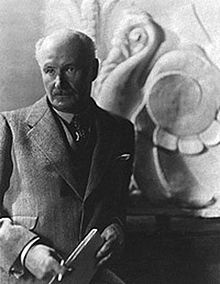John M. Lyle
| John M. Lyle | |
|---|---|
 |
|
| Born | 1872 Connor, County Antrim, Ireland |
| Died | 1945 Toronto |
| Nationality | Canadian |
| Alma mater | Yale University |
| Occupation | Architect |
| Practice | Atelier Lyle 1906-1943 |
| Buildings | Royal Alexandra Theatre |
| Projects | Worked on many Dominion Bank branches in Toronto 1911-1937 |
| Design | Royal Alexandra Theatre, Bank of Nova Scotia head office |
John MacIntosh Lyle (1872–1945) was an Irish born Canadian architect, designer, urban planner, and teacher active in the late 19th century and into the first half of the 20th century. He was a leading Canadian architect in the Beaux Arts style and was involved in the City Beautiful movement in several Canadian cities. In the 1920s, he worked to develop his vision of a uniquely Canadian style of architecture.
Lyle was born in Connor, County Antrim, Ireland on 13 November 1872. He came to Canada as a young child in 1878 and grew up in Hamilton, Ontario, where his father, Rev. Dr. Samuel Lyle, was minister of Central Presbyterian Church. Lyle attended the Hamilton School of Art. He trained as an architect at Yale University, enrolling in the École des Beaux-Arts, in Paris, France, in 1894. Following his graduation, he found work in 1896 with the New York architectural partnership of Howard & Cauldwell. Lyle subsequently became an associate with the New York firm of Carrère and Hastings—with which he was involved in the design of the New York Public Library (Fifth Avenue at 42nd St., 1897)—and became a member of the Society of Beaux-arts Architects.
In 1904, John Lyle designed and supervised the construction of the main building (now named Rogers House) at Pickering College, 16945 Bayview Avenue, Newmarket, ON L3Y 4X2. Was this his first major commission? Numerous sources exist including Professor Arthur Dorland' brief history of Pickering College in the 1942 Proceedings of the Royal Society of Canada.
Lyle returned to Canada in 1905 to begin work on the Royal Alexandra Theatre in Toronto. In 1906, he established his own company, Atelier Lyle, in Toronto.
During the 1920s, Lyle strove to develop a uniquely Canadian architectural style, incorporating traditional designs from the English and French colonial periods and stone, metal, plaster, fresco, glass and mosaic floral and faunal motifs inspired by the Canadian post-impressionist painters known as the Group of Seven.
...
Wikipedia
